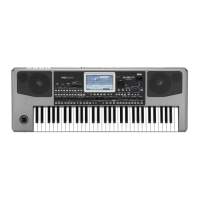258
Global mode
MIDI: General Controls
User Quarter Tone SubScale
This section is where you can program the Quarter Tone scale,
and save up to four Quarter Tone Scale (SC) Presets.
SC Preset buttons
Touch these buttons to recall the corresponding presets. Each pre-
set contains a custom detuning of each note of the scale (shown in
the upper scale diagram). It also memorizes the selected degree(s)
of the scale (shown in the lower scale diagram).
When no preset is selected, the default scale is automatically
recalled. This scale assigns a -50 cent value to all notes, and turns
all scale degrees off.
You can also select an SC Preset by assigning the relevant func-
tion to an Assignable Switch or Assignable Footswitch.
To save the current scale programming to a preset, while in this
page choose the “Write Quarter Tone SC Preset” command from
the page menu, then select one of the preset locations where to
save the current settings (see “Write Quarter Tone SC Preset” on
page 274).
Upper scale diagram
Use this diagram to set the detuning of each note of the scale.
-99…0…+99 Note detuning in cents. Zero is no detuning, ±50
is a full quarter tone up or down, ±99 is nearly
one whole semitone up or down.
Lower scale diagram
Use this scale to turn detuning on or off. Applied detuning will
depend on the programming set with the Upper scale diagram,
or recalled by selecting one of the SC Presets.
When a note is detuned, a black dot appears in the correspond-
ing note of the diagram.
MIDI: General Controls
This page allows you to select a MIDI Preset and set global
parameters for the MIDI communication.
MIDI Preset
Preset
MIDI channels can be automatically configured by selecting a
MIDI Preset. Each of them lets you automatically assign a value
to various MIDI parameters, to allow an easier connection with
a particular MIDI controller.
For detailed information about the preloaded MIDI Presets, see
“MIDI Preset” on page 353.
After selecting a MIDI Preset, you can apply any changes to each
channel’s settings. To store the changes in memory, select the
“Write Midi Preset” command in the page menu to save it to
memory (see “Write Midi Preset dialog box” on page 275).
Hint: You can restore the original MIDI Presets by using the “Fac-
tory Restore” command and choosing the “Global” option (page
“Utility” of the Media mode, see page 291). Please consider this
will reset all the Global data.
General Controls
Use these parameters to set MIDI Clock and Local Off.
Clock Send
Use this parameter to turn the clock information on the MIDI
OUT or USB Device port on or off.
Note: This parameter is automatically set to On when the instru-
ment enters standby.
Off The Pa900 does not send the MIDI Clock signal.
You c a n n o t s l ave a n o t he r i n s t r u m e n t t o t h e
Pa900, even when connected to the MIDI OUT
or USB Device port.
On The Pa900 sends the MIDI Clock signal. You can
slave another instrument to the Pa900 Tempo,
Start/Stop and Play/Stop commands. Connect the
other instrument to the Pa900 MIDI OUT or
USB Device port.

